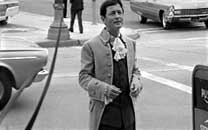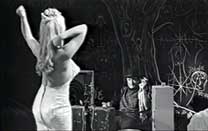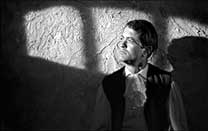 I,
MARQUIS DE SADE (1967)
I,
MARQUIS DE SADE (1967)Director: Richard Hilliard
Retromedia/Bayview
 I,
MARQUIS DE SADE (1967)
I,
MARQUIS DE SADE (1967)Richard Hilliard’s long lost I, MARQUIS DE SADE gets recovered on DVD courtesy of Retromedia Entertainment.

Donald Marquis (Sheldon Pearson) is working on a translation of the works of the Marquis De Sade – although it looks like he is translating not Sade’s original text but a biography on the author by Maurice Heine who rediscovered Sade’s works in the 1920s – for the prosecuting attorneys of an obscenity case against a publisher (who I guess was unaware that Grove Press started publishing English translations of Sade in 1965). As he delves deeper into the author’s works, he is sickened by the public perception of Sade as a madman, and that his own work might send another man to prison. When his doctor tells him that he has cancer, Donald walks away from his assignment and plunges into a world somewhere between fantasy and reality. He imagines himself as De Sade – voiced by one Clell Porter – whipping and torturing imaginary femmes in period clothes. In his waking life, he makes the acquaintance of a wealthy, overstuffed sugar mama – who he calls “The Hippo” in voice-overs – who pays for his services (apparently all he had to do was get rid of his glasses to become irresistible). Emboldened by his bank account and Sade’s philosophies, Donald pursues a series of women but – like his historical counterpart – finds his conquests thwarted in various ways: a British motorist takes him on a ride and then goes 180 on him (just as well since he then tries to kill her), he brings a “Queen Kong” and her wispy partner back to his sugar mama’s Frank Lloyd Wright-designed home and gets them wet (he pushes them into the pool) just as The Hippo returns and “smothers” him, so he decides to put The Hippo’s money to good use and hire some entertainment but she wears him out. Feeling trapped in these once liberating circumstances, he becomes more desperate and violent, deciding to “find happiness in crime”.
 Predating
American International’s DE SADE (1969) as well as Jess Franco’s
own official Sade adaptations JUSTINE (1969), EUGENIE: THE STORY OF HER JOURNEY
INTO PERVERSION (1970), and EUGENIE (1970), Hilliard’s film has some bits
that may have been inspired (or possibly anticipate) the delirium of Corman
and Franco; however, the most appropriate way to describe it might be the Sadeian
counterpart to Lou Campa’s adaptation of VENUS IN FURS (1967). There’s
breasts, whips, and blood.
Predating
American International’s DE SADE (1969) as well as Jess Franco’s
own official Sade adaptations JUSTINE (1969), EUGENIE: THE STORY OF HER JOURNEY
INTO PERVERSION (1970), and EUGENIE (1970), Hilliard’s film has some bits
that may have been inspired (or possibly anticipate) the delirium of Corman
and Franco; however, the most appropriate way to describe it might be the Sadeian
counterpart to Lou Campa’s adaptation of VENUS IN FURS (1967). There’s
breasts, whips, and blood.

The script is literate when stringing together lines from “Juliette”, “Eugenie de Franval” and “Philosophy in the Boudoir” (either Hilliard read these works or picked out these bits as quoted in the introductory essays included in Grove Press’ editions since a few of them crop up in Maurice Blanchot’s essay in “The Complete Justine, Philosophy in the Bedroom, and Other Writings”), but laughable the rest of the time (while musing about marrying and murdering his sugar mama and then going to the gas chamber, Donald – I’m guessing it’s the closest thing in English to Sade’s given name Donatien – likens the gas pellets to “Alka Seltzer sizzling in a bowl”). It’s an interesting early treatment of Sade – not seeming at all to be influenced by Freddie Francis’ THE SKULL (1965) or Robert Bloch’s source story – but isn’t risky (or risqué) enough nor does it realize the possibilities of the protagonist’s journey what with the hole dying-of-cancer thing staring him in the face and then subsequently forgotten.
 None
of the other female characters have names (in his narration, Donald alternately
calls his sugar mama “Queen Walrus” or “The Hippo”)
and they are only listed as “The Girls” in the opening credits –
presumably “Babette Bardot” is the dancer – with Pearson,
Porter, and Dorna MacDonald (as the bank teller late in the film) attached to
characters. The actress who plays the British motorist gives the best performance,
and is appropriately granted a goodly amount of screen time (and gets the last
word in). A “William Weaver” is credited as cinematography, but
Hilliard had previously shot his own debut THE LONELY SEX as well as the Del
Tenney productions THE CURSE OF THE LIVING CORPSE and THE HORROR OF PARTY BEACH,
so he either shot I, MARQUIS DE SADE himself or at least had more than a hand
in the visualization. The jazzy score is credited to Elliot Kaplan (THE FOOD
OF THE GODS).
None
of the other female characters have names (in his narration, Donald alternately
calls his sugar mama “Queen Walrus” or “The Hippo”)
and they are only listed as “The Girls” in the opening credits –
presumably “Babette Bardot” is the dancer – with Pearson,
Porter, and Dorna MacDonald (as the bank teller late in the film) attached to
characters. The actress who plays the British motorist gives the best performance,
and is appropriately granted a goodly amount of screen time (and gets the last
word in). A “William Weaver” is credited as cinematography, but
Hilliard had previously shot his own debut THE LONELY SEX as well as the Del
Tenney productions THE CURSE OF THE LIVING CORPSE and THE HORROR OF PARTY BEACH,
so he either shot I, MARQUIS DE SADE himself or at least had more than a hand
in the visualization. The jazzy score is credited to Elliot Kaplan (THE FOOD
OF THE GODS).
 The
back cover description says that the film was considered lost until a single
print was discovered in Sweden; if true, Retromedia’s interlaced, non-anamorphic
1.61:1 letterbox transfer probably derives not from the print itself but from
an aged likely-PAL video master of said source (the film on disc runs 69 minutes
while IMDb lists a 73 minute running time). Contrast is a bit grayish, looking
more hazy than 1960s Euro, and fine patterns – from chain link fences
to Donald’s hideous striped shirt – exhibit heavy aliasing. Edge
enhancement haloes are also prevalent, but this seems to be the only game in
town (if Something Weird, Vinegar Syndrome, or Code Red haven’t stumbled
across the negative, then the story about the print’s origin may indeed
be true). The mostly post-dubbed dialogue and the jazzy scoring fare better
in the Dolby Digital 2.0 mono track. Extras include the film’s trailer
(1:50) and a nudie short “Hollywood Beauties” (2:18).
(Eric
Cotenas)
The
back cover description says that the film was considered lost until a single
print was discovered in Sweden; if true, Retromedia’s interlaced, non-anamorphic
1.61:1 letterbox transfer probably derives not from the print itself but from
an aged likely-PAL video master of said source (the film on disc runs 69 minutes
while IMDb lists a 73 minute running time). Contrast is a bit grayish, looking
more hazy than 1960s Euro, and fine patterns – from chain link fences
to Donald’s hideous striped shirt – exhibit heavy aliasing. Edge
enhancement haloes are also prevalent, but this seems to be the only game in
town (if Something Weird, Vinegar Syndrome, or Code Red haven’t stumbled
across the negative, then the story about the print’s origin may indeed
be true). The mostly post-dubbed dialogue and the jazzy scoring fare better
in the Dolby Digital 2.0 mono track. Extras include the film’s trailer
(1:50) and a nudie short “Hollywood Beauties” (2:18).
(Eric
Cotenas)